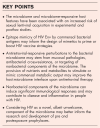Untangling the role of the microbiome across the stages of HIV disease
- PMID: 38935047
- PMCID: PMC11305932
- DOI: 10.1097/COH.0000000000000870
Untangling the role of the microbiome across the stages of HIV disease
Abstract
Purpose of review: The primate microbiome consists of bacteria, eukaryotes, and viruses that dynamically shape and respond to host health and disease. Understanding how the symbiotic relationship between the host and microbiome responds to HIV has implications for therapeutic design.
Recent findings: Advances in microbiome identification technologies have expanded our ability to identify constituents of the microbiome and to infer their functional capacity. The dual use of these technologies and animal models has allowed interrogation into the role of the microbiome in lentiviral acquisition, vaccine efficacy, and the response to antiretrovirals. Lessons learned from such studies are now being harnessed to design microbiome-based interventions.
Summary: Previous studies considering the role of the microbiome in people living with HIV largely described viral acquisition as an intrusion on the host:microbiome interface. Re-framing this view to consider HIV as a novel, albeit unwelcome, component of the microbiome may better inform the research and development of pre and postexposure prophylaxes.
Copyright © 2024 The Author(s). Published by Wolters Kluwer Health, Inc.
Conflict of interest statement
Figures


References
-
- Culp EJ, Goodman AL. Cross-feeding in the gut microbiome: ecology and mechanisms. Cell Host Microbe 2023; 31:485–499. - PMC - PubMed
-
This review comprehensively discusses cross-feeding as a mechanism of community composition in defined microbiomes and highlights the importance of considering the host as a symbiotic, integrated constituent of the microbiome.
-
- Gilliland A, Chan JJ, De Wolfe TJ, et al. Pathobionts in inflammatory bowel disease: origins, underlying mechanisms, and implications for clinical care. Gastroenterology 2024; 166:44–58. - PubMed
Publication types
MeSH terms
Grants and funding
LinkOut - more resources
Full Text Sources
Medical
Research Materials

